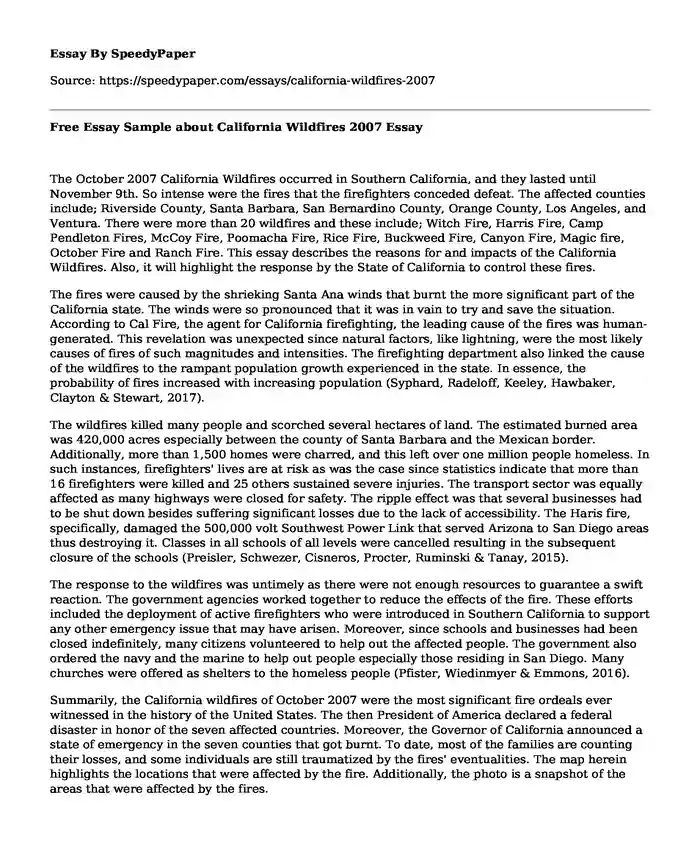The October 2007 California Wildfires occurred in Southern California, and they lasted until November 9th. So intense were the fires that the firefighters conceded defeat. The affected counties include; Riverside County, Santa Barbara, San Bernardino County, Orange County, Los Angeles, and Ventura. There were more than 20 wildfires and these include; Witch Fire, Harris Fire, Camp Pendleton Fires, McCoy Fire, Poomacha Fire, Rice Fire, Buckweed Fire, Canyon Fire, Magic fire, October Fire and Ranch Fire. This essay describes the reasons for and impacts of the California Wildfires. Also, it will highlight the response by the State of California to control these fires.
The fires were caused by the shrieking Santa Ana winds that burnt the more significant part of the California state. The winds were so pronounced that it was in vain to try and save the situation. According to Cal Fire, the agent for California firefighting, the leading cause of the fires was human-generated. This revelation was unexpected since natural factors, like lightning, were the most likely causes of fires of such magnitudes and intensities. The firefighting department also linked the cause of the wildfires to the rampant population growth experienced in the state. In essence, the probability of fires increased with increasing population (Syphard, Radeloff, Keeley, Hawbaker, Clayton & Stewart, 2017).
The wildfires killed many people and scorched several hectares of land. The estimated burned area was 420,000 acres especially between the county of Santa Barbara and the Mexican border. Additionally, more than 1,500 homes were charred, and this left over one million people homeless. In such instances, firefighters' lives are at risk as was the case since statistics indicate that more than 16 firefighters were killed and 25 others sustained severe injuries. The transport sector was equally affected as many highways were closed for safety. The ripple effect was that several businesses had to be shut down besides suffering significant losses due to the lack of accessibility. The Haris fire, specifically, damaged the 500,000 volt Southwest Power Link that served Arizona to San Diego areas thus destroying it. Classes in all schools of all levels were cancelled resulting in the subsequent closure of the schools (Preisler, Schwezer, Cisneros, Procter, Ruminski & Tanay, 2015).
The response to the wildfires was untimely as there were not enough resources to guarantee a swift reaction. The government agencies worked together to reduce the effects of the fire. These efforts included the deployment of active firefighters who were introduced in Southern California to support any other emergency issue that may have arisen. Moreover, since schools and businesses had been closed indefinitely, many citizens volunteered to help out the affected people. The government also ordered the navy and the marine to help out people especially those residing in San Diego. Many churches were offered as shelters to the homeless people (Pfister, Wiedinmyer & Emmons, 2016).
Summarily, the California wildfires of October 2007 were the most significant fire ordeals ever witnessed in the history of the United States. The then President of America declared a federal disaster in honor of the seven affected countries. Moreover, the Governor of California announced a state of emergency in the seven counties that got burnt. To date, most of the families are counting their losses, and some individuals are still traumatized by the fires' eventualities. The map herein highlights the locations that were affected by the fire. Additionally, the photo is a snapshot of the areas that were affected by the fires.
https://www.nasa.gov/images/content/194567main_socalfire3_20071026_516px.jpg
https://media.nationalgeographic.org/assets/photos/000/197/19735.jpg
References
Pfister, G. G., Wiedinmyer, C., & Emmons, L. K. (2016). Impacts of the fall 2007 California wildfires on surface ozone: Integrating local observations with global model simulations. Geophysical Research Letters, 35(19).
Preisler, H. K., Schweizer, D., Cisneros, R., Procter, T., Ruminski, M., & Tarnay, L. (2015). A statistical model for determining impact of wildland fires on Particulate Matter (PM2. 5) in Central California aided by satellite imagery of smoke. Environmental pollution, 205, 340-349.
Syphard, A. D., Radeloff, V. C., Keeley, J. E., Hawbaker, T. J., Clayton, M. K., Stewart, S. I., & Hammer, R. B. (2017). Human influence on California fire regimes. Ecological applications, 17(5), 1388-1402.
Cite this page
Free Essay Sample about California Wildfires 2007. (2022, Apr 08). Retrieved from https://speedypaper.com/essays/california-wildfires-2007
Request Removal
If you are the original author of this essay and no longer wish to have it published on the SpeedyPaper website, please click below to request its removal:
- Free Essay with Public Address System Research
- Free Essay: Why the Rich Are Getting Richer and the Poor, Poorer by Robert Reich
- Crimes of Assault, and Battery Against Individuals, Criminal Law Essay Example
- Free Essay: Intertextuality Between Dagoberto Gilb's Shout and Jhumpa Lahiri's A Temporary Matter
- Designing Benefit Plans - HRM Essay Example
- Essay Sample: Image of Women in the Selected Stories of Lu Xun and in the Joy Luck Club
- Essay Example Answers: Whether Amazon.com Positively or Negatively Affects our Daily Lives?
Popular categories





